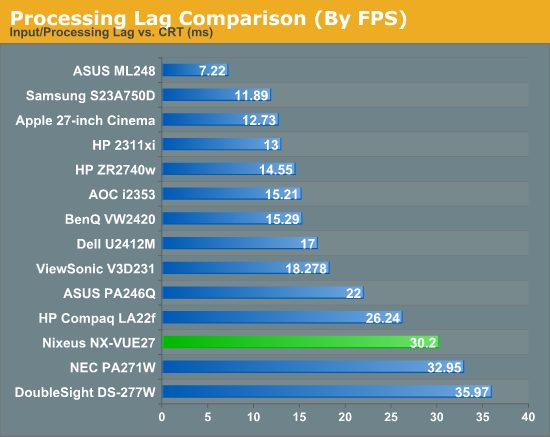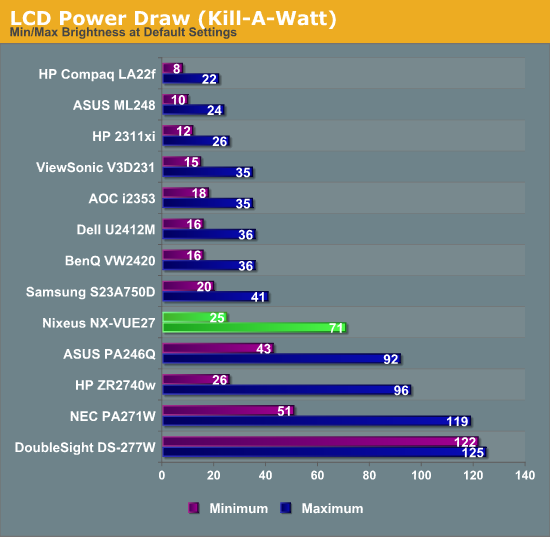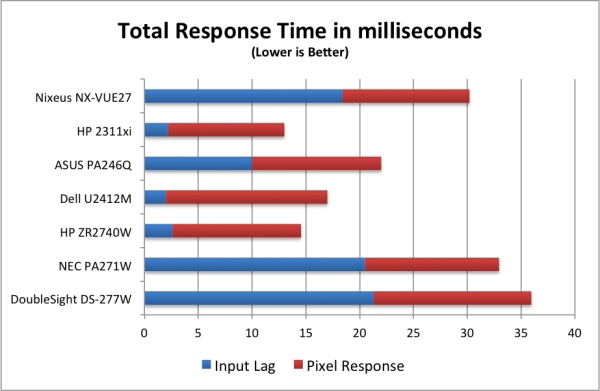Nixeus NX-VUE27 27" Monitor: High Resolution for the Masses
by Chris Heinonen on September 20, 2012 6:10 PM ESTInput Lag and Power Use
One important caveat to mention here is that I don’t have a CRT that can do 1440 lines of resolution natively. Because I have to run at a non-standard resolution compared to the Nixeus, you might see some additional lag being added to the input than if you ran natively, but there is no way for me to actually test the native input lag time. There is also no way on the Nixeus to set a 1080p image to be centered and not scaled, which might reduce lag by doing 1:1 mapping and bypassing the scaler but at the expense of only using part of the screen.

Here we see that input lag is 18.4ms and the pixel response time is a total of 23.6ms to rise and fall, so 11.8ms to completely change from one color to another. This gives us an overall lag number of 30.2ms, or almost two full frames in a standard 60fps game. Here the HP ZR2740w has almost the exact same pixel response time (11.95ms vs. 11.8, which is within the margin of error), but it only has 2.6ms of input lag. As the HP has no scaler and less processing to do with only a brightness control, this saves it a full frame of response time compared to the Nixeus.
I really wish I could be authoritative on what the 1440p results would be, as there may be no lag in that case, but I really can’t offer an answer there. If you know your video card can only do 1920x1080 resolution for games, then you can know you’ll have around two frames of lag on the Nixeus. If you’re a gamer, even if you aren't a hard core one, you might need to look elsewhere for now.

Power use is pretty reasonable on the Nixeus. For this I continue to use the full white screen as it does lead to more accurate numbers here, representing a worst case scenario. In that case, with the backlight at maximum, it consumes only 72 watts of power in use. That is less than all the other 27” monitors I have tested to this point, even the ones with LED backlighting systems. With the brightness at 20, it uses 25 watts of power, which is less than the HP but the HP has a brighter image at that level. Overall the power use numbers are very good for the Nixeus.











66 Comments
View All Comments
magreen - Thursday, September 20, 2012 - link
Especially given that there appears to be a real surplus of compute power in computers these days. The vast majority of users have no need for the compute power an i7 can deliver nor what most discrete GPUs can deliver. It's time to harness that power to finally give us resolution independent displays!peterfares - Thursday, September 20, 2012 - link
Windows fully supports DPI scaling since Vista. Most Microsoft programs fully support it and a few third party ones do, too. You can also try forcing high DPI mode on unsupported programs and see which ones work. Otherwise you can run them at their original pixel size or you can pixel scale them.Microsoft made a small push for higher DPI screens back during Vista's launch (along with hybrid hard drives) and it's only now when screens are finally moving up in DPI (look at the new laptops and tablets with 13" 1080p screens). Hybrid hard drives are also coming into play, though it's a bit late since SSDs are becoming big and cheap enough to completely replace them. Vista was just far ahead of its time.
cosmotic - Friday, September 21, 2012 - link
"vista was just far ahead of its time"Yeah, *thats* what vista was.
Malphas - Monday, September 24, 2012 - link
Actually it was, try Vista again today and you'll find it a near identical experience to Windows 7. The reason it was so awful at the time was due to underpowered hardware (made worse by the Vista Ready scheme Microsoft stupidly went along with to appease OEMs), incompatible hardware and software, buggy third party drivers, software that didn't play nice with UAC, etc. The actual OS itself is sound and again only cosmetically different from Windows 7, which received near universal praise.Penti - Friday, September 21, 2012 - link
Readyboost is still horrible and should die, seriously just give me an mSATA SSD + HDD if cheap storage is needed instead of 5400 rpm drives and small sub 64GB SSDs for caching. It's worse then a fast HDD. DPI-scaling is by no means an nice and clean way of scaling elements in Windows, not even all Microsoft apps support it. Though it's standard to have it scale on OEM-PCs since a long time now. Metro still scales horrible though.madmilk - Thursday, September 27, 2012 - link
It supports it in basically the same way the retina Macbook does (assuming Vista-style scaling): show natively high-res apps at full resolution, and scale up the rest.The difference is, Microsoft hasn't gone out and made noise about it, so pretty much everyone's apps are just using ugly scaling.
Sabresiberian - Friday, September 21, 2012 - link
"Resolution" has been perverted since LCDs came out. It used to be tied to pixel density. So, correctly speaking cell phones already have higher resolutions than monitors.;)
jeremyshaw - Thursday, September 20, 2012 - link
Hello,I've noticed you mentioned HDMI 1.4 support in the specifications list. Does that mean an AMD GCN or Intel Ivy Bridge (do the Ivy Bridge drivers support that, yet?) can output, via a HDMI output, a 2560x**** image at 60Hz?
peterfares - Thursday, September 20, 2012 - link
It's been stated that this display supports those resolutions over HDMI as long as you have a device capable of sourcing it. I don't know what can source it, if anything, yet.atotroadkill - Thursday, September 20, 2012 - link
From what I can find on the web, if you are using the CPU's embedded GPU for the HDMI output then no - only displayport can.To power 2560x1440 over HDMI you may need a descrete Nvidia 600 series card.